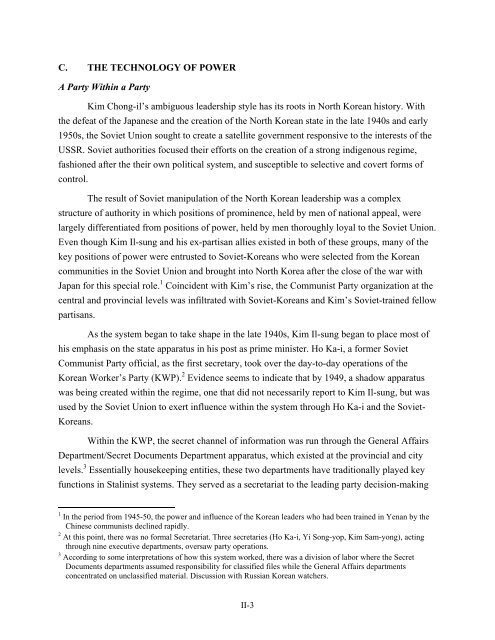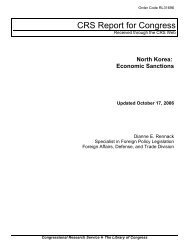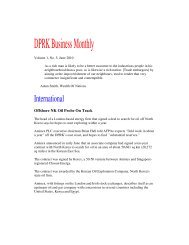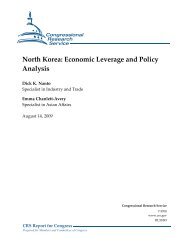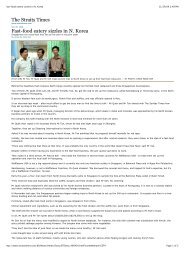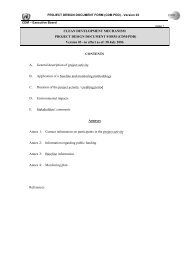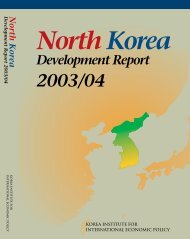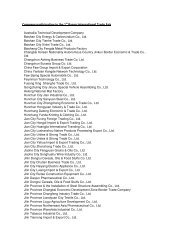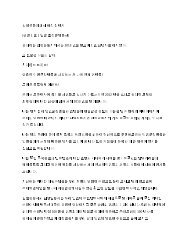North Korean Policy Elites - Defense Technical Information Center
North Korean Policy Elites - Defense Technical Information Center
North Korean Policy Elites - Defense Technical Information Center
You also want an ePaper? Increase the reach of your titles
YUMPU automatically turns print PDFs into web optimized ePapers that Google loves.
C. THE TECHNOLOGY OF POWER<br />
A Party Within a Party<br />
Kim Chong-il’s ambiguous leadership style has its roots in <strong>North</strong> <strong>Korean</strong> history. With<br />
the defeat of the Japanese and the creation of the <strong>North</strong> <strong>Korean</strong> state in the late 1940s and early<br />
1950s, the Soviet Union sought to create a satellite government responsive to the interests of the<br />
USSR. Soviet authorities focused their efforts on the creation of a strong indigenous regime,<br />
fashioned after the their own political system, and susceptible to selective and covert forms of<br />
control.<br />
The result of Soviet manipulation of the <strong>North</strong> <strong>Korean</strong> leadership was a complex<br />
structure of authority in which positions of prominence, held by men of national appeal, were<br />
largely differentiated from positions of power, held by men thoroughly loyal to the Soviet Union.<br />
Even though Kim Il-sung and his ex-partisan allies existed in both of these groups, many of the<br />
key positions of power were entrusted to Soviet-<strong>Korean</strong>s who were selected from the <strong>Korean</strong><br />
communities in the Soviet Union and brought into <strong>North</strong> Korea after the close of the war with<br />
Japan for this special role. 1 Coincident with Kim’s rise, the Communist Party organization at the<br />
central and provincial levels was infiltrated with Soviet-<strong>Korean</strong>s and Kim’s Soviet-trained fellow<br />
partisans.<br />
As the system began to take shape in the late 1940s, Kim Il-sung began to place most of<br />
his emphasis on the state apparatus in his post as prime minister. Ho Ka-i, a former Soviet<br />
Communist Party official, as the first secretary, took over the day-to-day operations of the<br />
<strong>Korean</strong> Worker’s Party (KWP). 2 Evidence seems to indicate that by 1949, a shadow apparatus<br />
was being created within the regime, one that did not necessarily report to Kim Il-sung, but was<br />
used by the Soviet Union to exert influence within the system through Ho Ka-i and the Soviet-<br />
<strong>Korean</strong>s.<br />
Within the KWP, the secret channel of information was run through the General Affairs<br />
Department/Secret Documents Department apparatus, which existed at the provincial and city<br />
levels. 3 Essentially housekeeping entities, these two departments have traditionally played key<br />
functions in Stalinist systems. They served as a secretariat to the leading party decision-making<br />
1 In the period from 1945-50, the power and influence of the <strong>Korean</strong> leaders who had been trained in Yenan by the<br />
Chinese communists declined rapidly.<br />
2 At this point, there was no formal Secretariat. Three secretaries (Ho Ka-i, Yi Song-yop, Kim Sam-yong), acting<br />
through nine executive departments, oversaw party operations.<br />
3 According to some interpretations of how this system worked, there was a division of labor where the Secret<br />
Documents departments assumed responsibility for classified files while the General Affairs departments<br />
concentrated on unclassified material. Discussion with Russian <strong>Korean</strong> watchers.<br />
II-3


